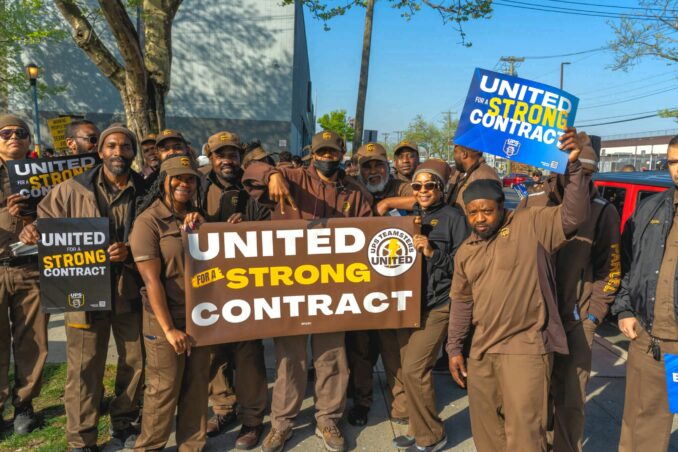Teamsters, UAW prepare for big strikes
Two major private-sector unions, the Teamsters (IBT) and the United Auto Workers (UAW) have begun mobilizing for possible strikes when contracts expire with UPS Aug. 1, and the “Big Three” (Ford, General Motors and Stellantis, which includes Chrysler Sept. 14. Big Three contracts with Unifor, which represents Canadian auto workers, also expire in September.
The Teamsters, with 1.2 million members, is the largest private sector union in the U.S., and about 330,000 Teamsters work for UPS. Its last UPS strike was in 1997, when Ron Carey was president. Carey was ousted after the successful strike in an alleged financial scandal; the federal charges were later proven false.
From Carey’s removal until 2021, the union was led by James Hoffa, but the Hoffa leadership alienated the membership when it imposed a weak contract with UPS on the rank and file — one that a majority had rejected. This bureaucratic maneuver was permissible under the union constitution, but it was unpopular and led to the defeat of Hoffa’s chosen successor and the election of Sean O’Brien by a two-to-one margin.
The OZ Team — O’Brien, Vice President Fred Zuckerman and their slate of candidates — were supported by Teamsters for a Democratic Union.
Since Aug. 1, 2022, UPS Teamsters have been waging what’s called a “contract campaign,” designed to rally members and supporters around key contract demands in advance of an expected strike. The union website has posted downloadable rally signs, with slogans like “No more! Two tier, Subcontracting, Harassment” and “End excessive overtime,” and demands for just treatment of part-time workers.
Members are attending strike-preparation activities, like Zoom discussions and “parking lot rallies” outside their workplaces to press their key demands.

UPS Members of Teamsters Local 804 hold a contract rally, April 21, 2023, Brooklyn, New York. Credit: Teamsters Local 804
New, militant leadership in UAW
The UAW is moving in a similar direction. In the union’s first virtual “town hall” with the membership on May 31, President Shawn Fain took a militant stance: “These companies have been extraordinarily profitable, and our members have created incredible value for these companies during some really hard and dangerous years. They can afford our demands, and we expect them to pony up!”
Secretary-Treasurer Margaret Mock added, “These companies can afford all of our demands. Since the Great Recession, as a result of our members’ hard work, the Big Three have been amassing an ocean of money.”
The union’s three vice presidents — Mike Booth, Rich Boyer and Chuck Browning — addressed the central bargaining demands around ending unequal pay and benefit tiers, restoring the cost-of-living allowance (COLA) and maintaining job security during the transition to electric vehicles (EVs).
The last point is of critical importance, as the Big Three are using the new technology to once again restructure the auto industry to shrink the workforce. EVs require fewer workers to assemble than internal combustion engine vehicles. On top of that, the companies are getting around paying the wages and benefits in their contracts with the UAW by forming new “joint venture” battery companies with third parties, such as LG, Panasonic and Samsung.
The new UAW leaders are the first in the union’s history to be elected directly by the rank and file. Seven of the 14 International Executive Board members were elected with the support of the grassroots caucus Unite All Workers for Democracy. UAWD is promoting the contract campaign strategy in the UAW.
‘The UAW’s defining moment’
The UAW’s position is that the joint venture plants should be covered by the master agreements. The Big Three bosses say the union has to organize each plant individually and bargain new contracts separately. Right now, workers at the Ultium (GM and LG) plant in Lordstown, Ohio, where they recently voted in the UAW, make roughly half the pay of their counterparts at GM plants. GM permanently closed its Lordstown assembly plant in 2019.
“In 100 days, contracts expire for 150,000 autoworkers at Ford, General Motors and Stellantis,” the union stated on its website June 7. “UAW members are gearing up to win big for working-class communities across the country.
“This contract fight will be the UAW’s defining moment, as the auto industry transitions to electric vehicles. We’re setting a new standard, and members are united in the fight for our core demands.”
The fighting words coming from the UAW and the Teamsters are a breath of fresh air to workers, after decades of concession bargaining and class collaboration by previous leaders.
The fight will not be easy, given the current stage of capitalist decline and with a potential economic recession looming on the horizon. The profit-hungry capitalists are in no mood to return the union workers’ gains made in the past that the bosses have clawed back over the last few decades.
But with the powerful writers strike — which may soon be expanded to include actors and many other film and media workers — continuing against the entertainment industry, and strikes at UPS and the Big Three on the horizon, class-struggle unionism can help to unify the working class against capital.
Martha Grevatt is a retired UAW Stellantis worker and served on the executive board of UAW Locals 122 and 869.

